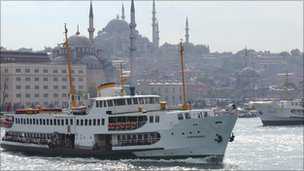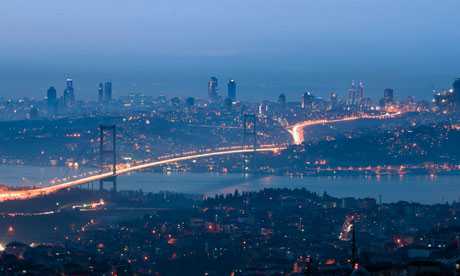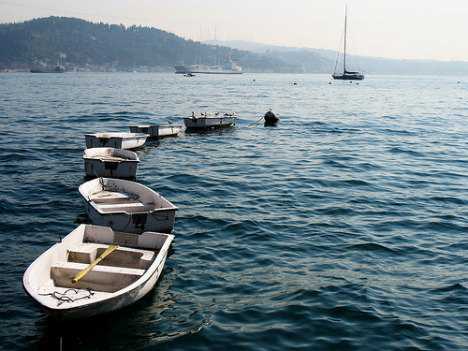Cathy Packe explores lively districts and historic sites along both sides of the Bosphorus
Saturday, 25 June 2011

The world’s most spectacular continental divide? Surely the Bosphorus, the 19-mile waterway that defines Istanbul. On the European side, the Topkapi Palace presides over the southern limit, while the minarets of great mosques puncture the sky. Every visitor to the city should take a ferry across the divide from the Eminonu quay, from where boats shuttle constantly to several ports on the Asian side: choose Harem to see the Selimiye Barracks, where Florence Nightingale was based, or Uskudar for the small but attractive Semsi Pasa mosque, designed by a major architect of the Ottoman Empire, Mimar Sinan.
For centuries the Bosphorus has been a strategic link between the Black Sea and Russia to the north and the Mediterranean – via the Sea of Marmara and the Aegean – in the south. The best way to appreciate its significance is to wander its length.
On Sunday mornings, amateur fishermen cast their lines into the water, then wait patiently for something to bite. Buckets of small fish, destined to be fried for supper, attract the attention of curious children, while families buy chestnuts or mussels from stalls along the waterfront.
The usual visitor experience of the Bosphorus is on one of the cruise boats that depart from Eminonu pier. But while there is plenty to see from the water, I decided on a closer exploration, to get to the mouth of the strait by staying, mostly, on dry land.
The bustling streets that skirt the European shore soon turn into a pleasant promenade and calmer suburbs: Ortakoy with its waterside bars, and Arnavutkoy, full of attractive cafés. Glamorous summer houses and chic restaurants mask the fact that for centuries the Bosphorus has been one of the most bitterly contested waterways in history.
The Roman Emperor Constantine was aware of its strategic significance when he chose the site of his new capital, Constantinople, in the 4th century; and even before they conquered the city some 1,100 years later, the Ottomans started building fortifications along the water.
Rumeli Hisari, “the Fortress of Europe”, looks more like a pleasure palace than a defensive site, cascading as it does down the hillside and stopping just before it tumbles into the water. Now, deeply crenellated walls surrounding a series of towers are all that is left. Trees and shrubs have taken over the interior, leaving space only for a recently constructed amphitheatre which is used for outdoor concerts in the summer. But when it was built by Mehmet the Conqueror in 1452, the fortress was a prominent statement of his intention to advance on Constantinople.
Just beyond Rumeli Hisari is the newer of the two suspension bridges that span the Bosphorus, a useful intercontinental link for trucks and cars but which is off limits to pedestrians. Yet private enterprise is flourishing on both continents, and I was soon directed towards the waterfront and a local boatman. I clambered into his small craft, quickly followed by a family of eight. Together we chugged across the water from Europe to Asia, groaning occasionally as we were buffeted by wash from larger vessels.
The boat skirted past Anadolu Hisari, the Asian counterpart of the European fortress, and moored at the tiny landing stage at Kanlica. A cat lay sleeping on a bench. An elderly man was selling bread rolls from a stall near the ferry stop, and a small market was doing a brisk trade in hats and cheap jewellery.
On the road beyond I found a bus heading north. Beside the water were family groups enjoying a weekend barbecue, but as the bus turned inland through dense pine forest, soldiers on patrol behind walls of sandbags provided a stark reminder that the shore is fiercely guarded territory.
At the end of the road is Yoros Castle, a striking structure built in alternating horizontal stripes of stone and brick, a typical Byzantine design. Despite the presence of the military around the headland, this is the perfect spot to find peace and quiet. The silence is broken by a couple of donkeys braying in the distance. The view is of the open sea merging gently into the horizon.
In the past, chains stretched across the mouth of the Bosphorus where it met the Black Sea. Imposing fortifications on both sides of the water would have made sailing south a hazardous affair. Now, all it takes is a pleasant afternoon cruise.
Below Yoros Castle is the picturesque village of Anadolu Kavagi, with its popular fish restaurants overlooking the water. I headed downhill to wait for the ferry that would take me back to Istanbul. The trip afforded me a different perspective, and a sense of just how close Europe and Asia are at the narrowest point in the strait. And although I’d crossed from one continent to the other on my journey north, it was good to experience the Bosphorus as so many visitors – from Phoenicians to 21st-century tourists – have done: from the water.
Travel essentials: Istanbul
Getting there
* The main airport, Ataturk, is served by Turkish Airlines (020-7471 6666; turkishairlines.com) from Heathrow, Stansted, Birmingham and Manchester and BA (0844 493 0787; ba.com) from Heathrow. Sabiha Gokcen Airport is served by Turkish Airlines and Pegasus (0845 084 8980; flypgs.com) from Stansted, and by easyJet (0905 821 0905; easyjet.com) from Luton and Gatwick.
Staying there
* The writer travelled as a guest of Hilton Hotels and stayed at the Hilton Istanbul (00 90 212 315 6000; hilton.co.uk), on the European side of the Bosphorus at Cumhuriyet Caddesi Harbiye. Doubles start at €260 including breakfast.
More information
* Britons must pay £10 (in cash) for a visa on arrival.
* Tourist Office: 020-7839 7778; gototurkey.co.uk.





